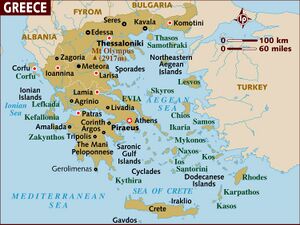Sindos
| Author: Laxman Burdak, IFS (R). |

Sindos is a suburb of Thessaloniki, Greece. It was nhabited by the Sindi, a people of Asiatic Sarmatia. The site of their capital, Sindos, or Sinda, is supposed to have been the modern Anapa. [1]
Variants
Jat Gotras Namesake
- Sindar = Sinda = Sindos (Greek: Σίνδος) (Pliny.vi.5)
- Sindhu = Sindus = Sindos (Greek: Σίνδος) (Pliny.vi.5)
Location
It is the seat of the municipality of Delta. Sindos is home to the main campus of the Alexander Technological Educational Institute of Thessaloniki and the Industrial Zone of the city.
History
In antiquity, Sindos was noted by Herodotus (vii. 123); and Stephanus of Byzantium as a maritime town of Mygdonia in Macedonia, between Therme and Chalastra.[2]
The site of the ancient town is tentatively identified with a location near modern Nea Ankhialos,[3] located at 40°40′12″N 22°48′00″E.[4]
Mention by Pliny
Pliny[5] mentions.... Next to this, is the promontory of Cruni, after passing which, we find the Toretæ upon a lofty ridge of mountains. The city of Sindos17 is distant from Hierus sixty-seven miles and a half; after passing which, we come to the river Setheries. (6.) From thence to the entrance of the Cimmerian Bosporus the distance is eighty-eight miles and a half.
17 Inhabited by the Sindi, a people of Asiatic Sarmatia. They probably dwelt in and about the modern peninsula of Taman, between the Sea of Azof and the Black Sea, to the south of the river Hypanis, the modern Kouban. The site of their capital, Sindos, or Sinda, is supposed to have been the modern Anapa. Parisot conjectures that this place was one of the ancient settlements of the Zigeunes, the modern Bohemians or Gypsies. He seems to found his opinion upon some observations of Malte Brun (Précis de Geographie, vol. vi.) upon the origin of the Gypsy race, which will amply repay the perusal.
References
- ↑ Natural History by Pliny Book VI/Chapter 5,fn-17
- ↑ Public Domain Smith, William, ed. (1857). "Sindus". Dictionary of Greek and Roman Geography. Vol. 2. London: John Murray.
- ↑ Richard Talbert, ed. (2000). Barrington Atlas of the Greek and Roman World. Princeton University Press. p. 50, and directory notes accompanying.
- ↑ Lund University. Digital Atlas of the Roman Empire.
- ↑ Natural History by Pliny Book VI/Chapter 5

